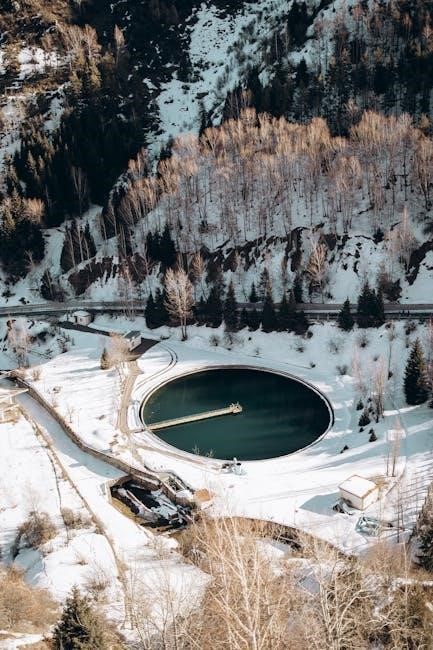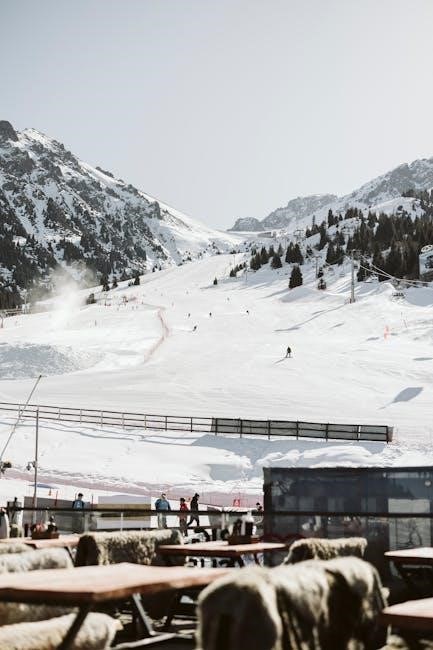Proper skate ski length is crucial for performance and comfort. This guide covers key factors, size charts, and expert tips to help you choose the right skis.
Understanding the Importance of Proper Ski Length
Proper ski length is essential for optimal performance, efficiency, and control. Skis that are too long can be difficult to maneuver, while skis that are too short may lack glide and stability. Incorrect sizing can lead to poor technique, reduced speed, and increased fatigue. For skate skiing, where precision and power are critical, the right length ensures better edge control and smoother strides. Choosing the correct length also enhances comfort and reduces the risk of injury. A well-fitted ski maximizes your skiing experience, making it vital to carefully consider height, weight, and skiing style when selecting your skis.
Overview of Skate Skiing and Its Equipment
Skate skiing is a dynamic winter sport that combines speed and agility on snow-covered trails. Unlike classic cross-country skiing, skate skiing uses shorter skis and a side-to-side skating motion, similar to ice skating. Key equipment includes specialized skis, lightweight boots, and poles with larger baskets for stability. Skate skis are typically 10-15 cm shorter than classic skis, with a stiffer flex to enhance power transfer. The right equipment setup is crucial for performance, making proper ski length selection a foundational step in optimizing your experience on the snow.

Key Factors Affecting Skate Ski Size
Ski length depends on height, weight, skiing style, and terrain. Proper fit ensures balance, control, and optimal performance for all skiers.
Skier’s Height and Weight
A skier’s height and weight are fundamental in determining the ideal ski length. Taller individuals typically require longer skis for stability, while shorter skiers benefit from shorter lengths. Weight also plays a role, as heavier skiers may prefer stiffer skis for better support. For example, a skier weighing between 40-65 kg might opt for a 165 cm ski, whereas someone between 75-105 kg could choose a 185 cm ski. Balancing these factors ensures optimal performance and comfort on the snow.
Skiing Style and Ability Level
Skiing style and ability level significantly influence the ideal skate ski length. Beginners often benefit from shorter skis, which are easier to maneuver, while advanced skiers may prefer longer skis for greater speed and glide efficiency. Technique also plays a role; skiers with a more dynamic style might opt for slightly shorter skis to enhance agility. Balancing skiing style with ability level ensures the skis perform optimally for each individual, whether cruising on groomed trails or racing at high intensity.
Intended Terrain and Usage
Intended terrain and usage are critical in determining skate ski length. Skis for groomed trails are typically longer to maximize glide and speed, while softer snow conditions may require slightly shorter skis for better float. Racing skis are designed to be longer and stiffer for optimal performance, whereas recreational skis prioritize ease of use. The choice between all-round, racing, or touring skis depends on where and how you plan to ski most often. Matching the ski length to the terrain ensures better performance, control, and overall skiing enjoyment.
General Skate Ski Length Recommendations
Adult skate skis typically range from 171cm to 191cm, with length determined by height, weight, and skiing style. Juniors usually start shorter, around 140cm to 160cm. Proper fit ensures optimal performance and control, balancing glide and maneuverability. Using a size chart effectively helps tailor the ski length to individual needs, ensuring the best skiing experience. Always consider personal preference and skiing technique when selecting the ideal length for your adventures on the snow.
Length Ranges for Adults and Juniors
Adult skate skis typically range from 171cm to 191cm, with ideal lengths determined by height, weight, and skiing ability. For juniors, skate skis are shorter, usually between 140cm and 160cm, to accommodate smaller frames and skill levels. Weight plays a significant role, with lighter skiers opting for shorter lengths and heavier skiers requiring longer skis for stability. For example, a 40-65kg skier might choose a 165cm ski, while a 75-105kg skier would prefer a 185cm ski. Proper sizing ensures efficient glide and control, making the skiing experience enjoyable and effective for all ages and abilities.
How to Use a Ski Size Chart Effectively
Using a ski size chart effectively starts with knowing your height, weight, and skiing style. Match these factors to the chart’s recommendations to narrow down your options. For skate skis, consider that they are typically 10-15cm shorter than classic skis. Beginners may prefer shorter skis for easier maneuverability, while advanced skiers might opt for longer lengths to maximize glide. Adjustments can be made based on personal preference and specific terrain. Always cross-reference multiple sources to ensure accuracy and find the perfect fit for your skiing needs and goals;

Specific Brand Size Guides
Salomon and Rossignol offer detailed size charts, recommending ski lengths based on height, weight, and ability. Salomon skis range from 165-185cm for lighter skiers, while Rossignol adjusts for skill level.
Fischer Skate Ski Size Chart
Fischer offers a detailed size chart for skate skis, ensuring optimal performance. Skis range from 165cm to 200cm, with recommended lengths based on skier height and weight. For example, a 180cm ski suits skiers weighing 40-50kg, while a 185cm ski is ideal for 45-55kg. Fischer skis are designed for efficiency, with lightweight construction and precise camber for better glide and control. Their size guide helps skiers find the perfect fit, balancing length, flex, and performance for a superior skating experience. Proper sizing ensures maximum energy transfer and comfort, making Fischer a top choice for both beginner and advanced skiers.
Madshus Skate Ski Length Recommendations
Madshus provides tailored recommendations for skate ski lengths, ensuring optimal performance. Skis range from 165cm to 205cm, with sizes corresponding to skier height and weight. For instance, a 175cm ski suits skiers weighing 55-80kg, while a 185cm ski is designed for 75-105kg. Madshus emphasizes proper fit for efficiency, with constructions that balance stiffness and flexibility. Their guide helps skiers select the ideal length, ensuring maximum glide and control; By aligning ski length with individual needs, Madshus delivers enhanced performance and comfort for both training and racing.
Salomon and Rossignol Size Guidelines
Salomon and Rossignol offer detailed size charts for skate skis, tailored to skier height and weight. Salomon recommends sizing 5-15cm longer than body height, with ranges from 165cm to 195cm. Rossignol focuses on weight categories, suggesting 165cm for 40-65kg and 185cm for 75-105kg. Both brands emphasize flex and camber for optimal performance, ensuring skis match skier ability and terrain. Their guidelines help skiers find the perfect balance of length, stiffness, and glide, enhancing efficiency and control on snow. Proper sizing ensures maximum enjoyment and performance for both brands’ skate ski collections.

How to Calculate Your Ideal Skate Ski Length
Start with your height, add 5-15cm for skate skis. Adjust based on weight and style: shorter for lighter skiers, longer for advanced or heavier users. Ensure optimal performance.
Step-by-Step Measurement Guide
To determine your ideal skate ski length, start by measuring your height in centimeters. Next, consider your weight and skiing ability. For beginners, subtract 5-10cm from your height, while advanced skiers add 5-10cm. Adjust further based on weight: lighter skiers may prefer shorter skis for better control, while heavier skiers benefit from longer skis for stability. Use a size chart to refine your selection, ensuring the skis align with your technique and terrain preferences. This balanced approach guarantees optimal performance and comfort on the snow.
Adjusting for Weight and Skiing Technique
Your weight and skiing technique significantly impact ski length. Lighter skiers may prefer shorter skis for easier control, while heavier skiers benefit from longer skis for stability. Beginners often opt for shorter lengths to improve maneuverability, whereas advanced skiers can handle longer skis for speed and glide. Technique also plays a role, as aggressive skiers may prefer stiffer, longer skis for better energy transfer. Balancing weight and technique ensures optimal performance, whether you’re cruising groomed trails or racing competitively. Proper adjustment enhances efficiency, comfort, and overall skiing enjoyment.
Special Considerations
When selecting skate skis, consider unexpected terrain changes, personal skiing frequency, and any physical limitations that might affect your performance and comfort on the snow.
Junior Skate Ski Sizing Tips
For juniors, proper ski length is essential to ensure comfort and performance. Skate skis for kids are typically 10–15cm shorter than classic skis. Beginners should start with skis 5–10cm shorter than their body height, while advanced juniors can opt for skis 5cm longer. Weight and ability level also play a role—lighter skiers may prefer shorter skis, while heavier or more skilled juniors might need longer ones. Always consult a size chart or seek professional advice to ensure the best fit for growing skiers, as proper sizing enhances both performance and enjoyment on the snow.
Choosing the Right Flex for Your Weight
Finding the right flex for your weight ensures optimal performance and comfort. Lighter skiers benefit from softer flex skis for easier maneuverability, while heavier skiers need stiffer skis for better edge control. Generally, skis with a medium flex are suitable for most users, but precise needs vary. For example, a skier weighing 40–65kg may prefer a softer flex, while those over 75kg require stiffer options. Consider your skiing style—aggressive skiers may prefer stiffer skis regardless of weight. Always test skis or consult a professional to ensure the best fit for your weight and technique.
Choosing the right skate ski length ensures optimal performance and comfort. Consider height, weight, skiing style, and terrain to find your ideal fit for an enhanced experience.
Final Tips for Choosing the Perfect Skate Skis

When selecting skate skis, prioritize fit and flexibility based on your skiing style. For beginners, shorter skis enhance control, while advanced skiers benefit from longer lengths for speed and glide.
